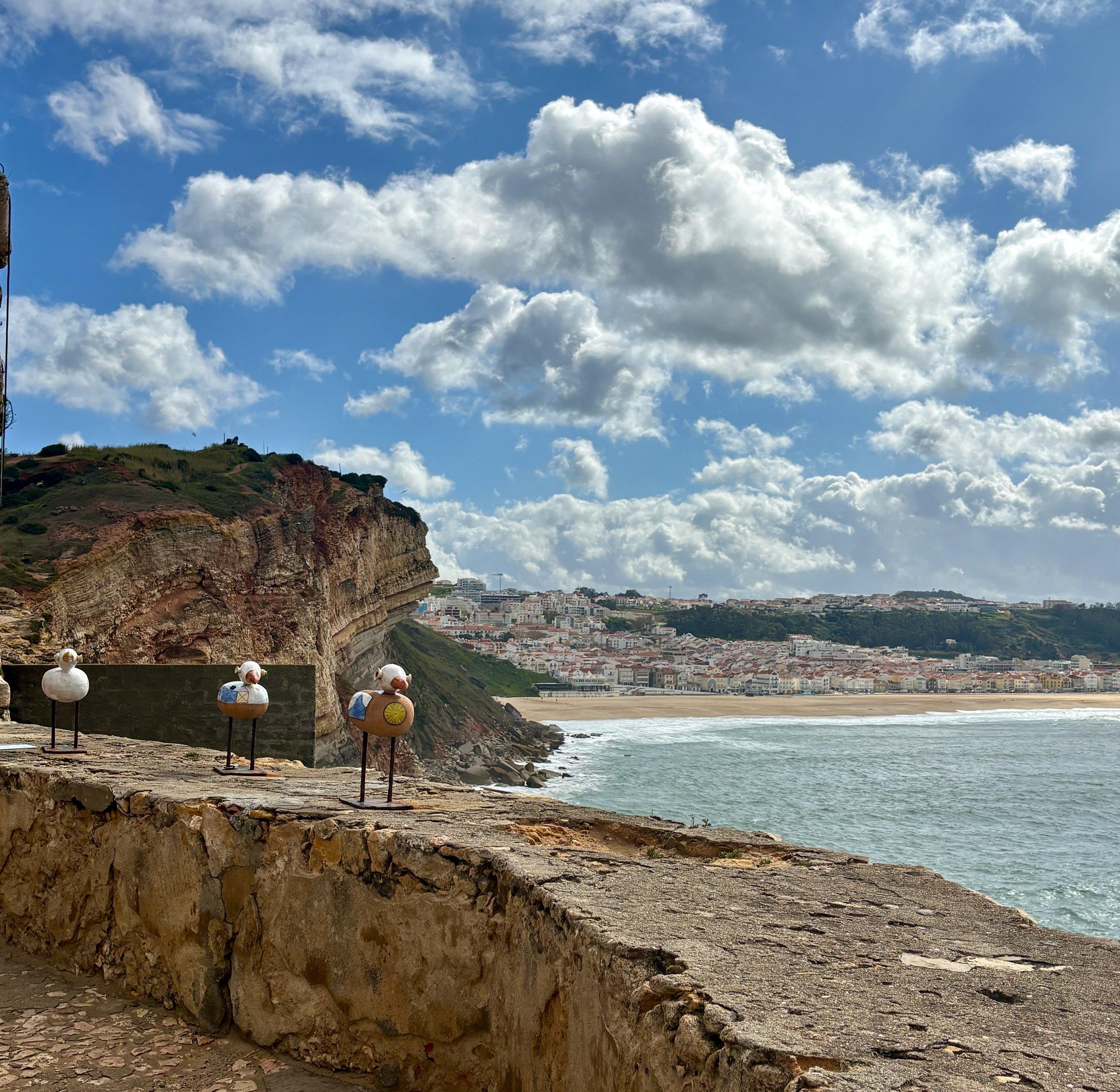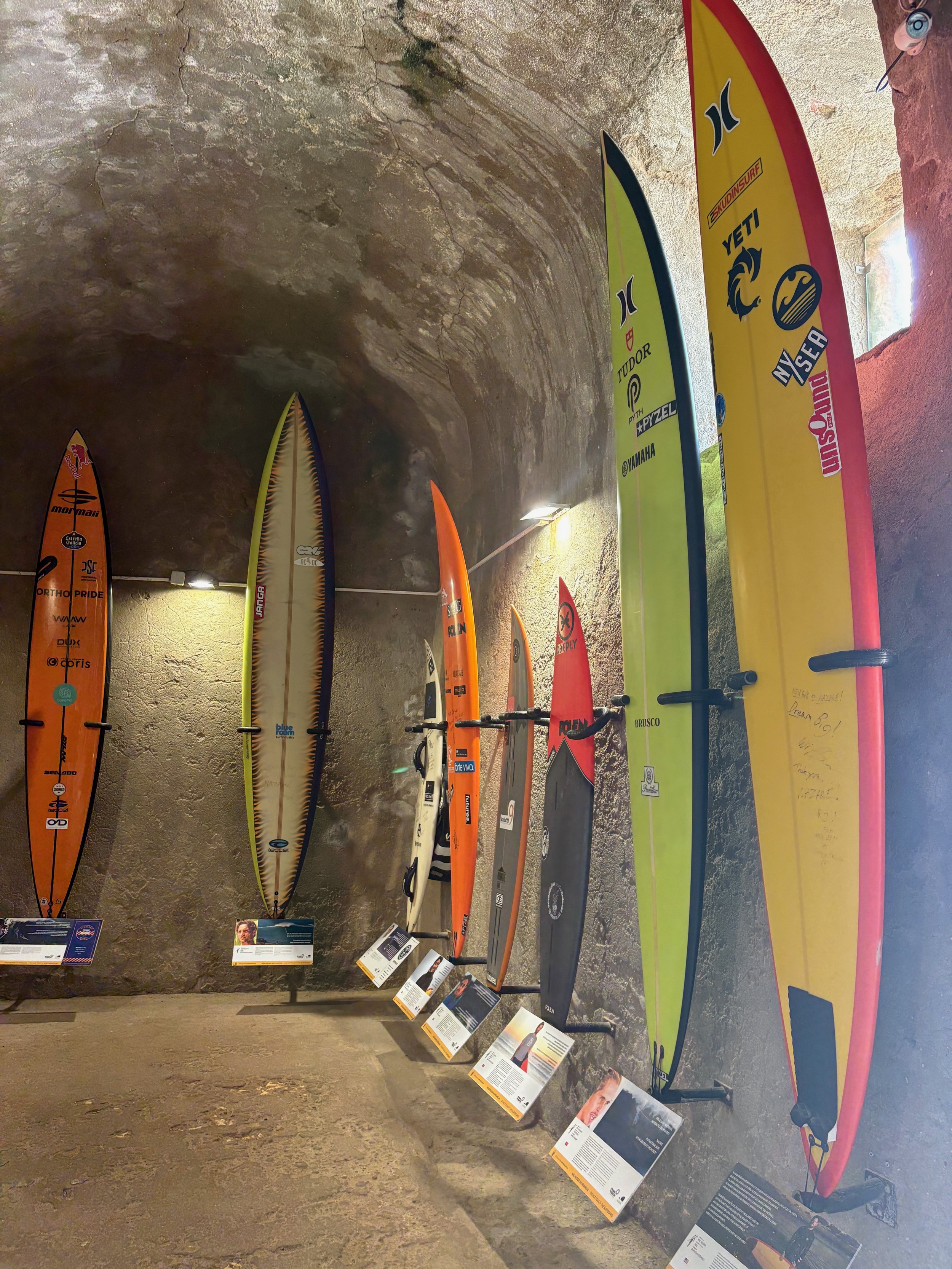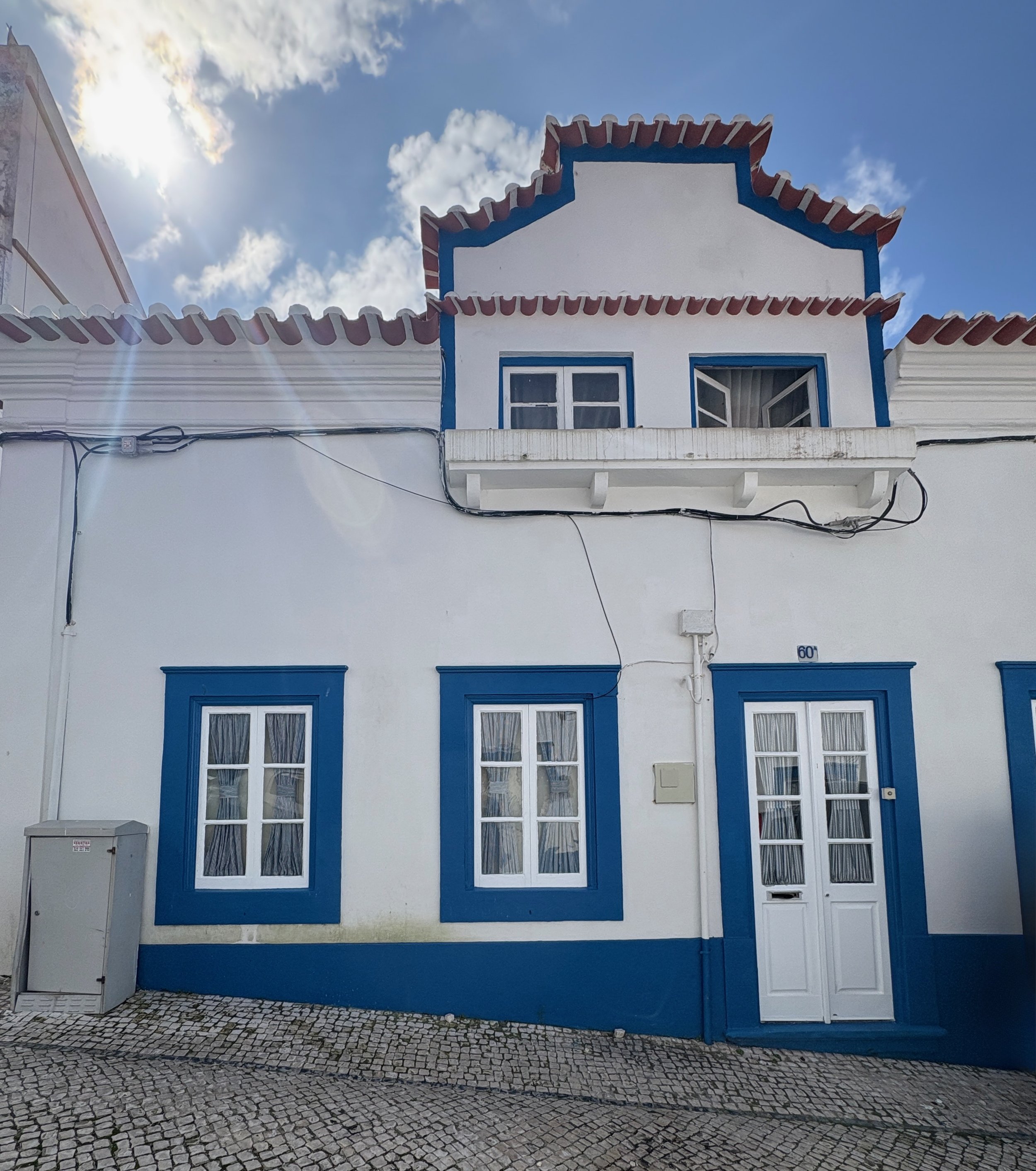Nazaré by the Sea
Our second month long stay in Portugal has been in Nazaré which is about a 90 minute drive north of Lisbon on the Silver Coast of Portugal. Nazaré is a small fishing village, it is a premier surfing destination, and it is a vibrant tourist town. Keep reading to see how it manages to be all three beautifully.
Nazaré is comprised of three main locations: Praia (the village), Sitio (the upper city) and Pederneira (to the east and on another hilltop). To get from the main village up to Sitio you have two choices: a VERY steep climb or the funicular! We chose the funicular. It is only €4 for a return trip and is used by locals and tourists alike.
The view from the top of the funicular
The Story of Nazaré
Legend has it that the city of Nazaré got its name from a small statue of the Virgin Mary that was brought from Nazareth in the Holy Land in the 4th century by a monk. In 1182, locals believe a miracle happened when the Virgin Mary saved the life of a Portuguese Templar knight while he was deer hunting. In that spot in Sitio the Sanctuary of Our Lady of Nazaré was built to honor the Virgin Mary. Today, you can find a small statue of Mary in the sanctuary.
Fish, Fish, and more Fish
With over 1000 miles of coastline, fishing has always been a mainstay of Portugal and here along the Silver Coast over 300 varieties of fish and shellfish provide a staple of the local diet. On Praia de Nazaré, the main beach for the village you’ll find the Dry Fish Museum. Before the days of refrigeration, drying fish was the common way to preserve freshly caught fish and is a tradition maintained today by the older generation. As you walk the boardwalk along the beach, your nose will tell you that you are approaching the museum! Here you’ll find racks of seafood and fish drying in the sun. Countless varieties of fish, octopus, squid, eels, shellfish and more can be found.
Would you eat any of these?
At the Dried Fish Museum, at the local market, and throughout the winding streets of the village you’ll find women wearing the traditional Seven Skirts. The traditional attire ties back to the fishing culture of Nazaré, where the men went out daily to fish and the wives waited ashore for their return. The legend varies depending on who you ask. You’ll hear the story that there was one skirt layer for each wave that brought their husbands home. Or perhaps that they needed the seven layers to stay warm in the cold Atlantic breeze while they waited for their husbands to bring home the day’s catch. Some say that the layers represented the seven colors of the rainbow that are so prevalant here on the coast. And still others say that they represent the seven virtues. Whatever legend you chose to believe, its like being transported back in time to see the women today wearing the skirts as they go about their daily lives.
Riding the Waves in Nazaré
In addition to the Sanctuary of Our Lady of Nazaré and the spectacular views of the village, Sitio is where you’ll find Forte de São Miguel Arcanjo and the waves that have made Nazaré a premier surfing destination. The fort itself dates back to the 16th century and became a lighthouse in the early 20th century. There is a monument to the famed discoverer Vasco da Gama here. It was even overtaken by Napoleon’s troops in the 1800s. The fort is a 15-20 minute walk west from the funicular. Along the way you’ll find stunning overviews of the village and Praia de Nazaré along with food trucks and signs for surfing competitions.
Seagulls are everywhere…both in art and real life!
The fort is now a surfing museum. At just €2 to enter it is well worth the stop. There, you can learn about the underwater Nazaré canyon which shaped this beach and makes it ideal for big wave surfing. You will see surfboards from some of the worlds top surfers, then climb up to the roof for jaw dropping views. Nazaré has been a surfing destination since the 1960s, but really made a name for itself in the early 2011. That is when Garret MacNamara set the World Record by surfing a 78 foot wave. Yes. 78 feet high. There’s a great HBO documentary called 100 Foot Wave about MacNamara and others who have braved the treacherous waters here to set records. Big wave season is November - March, with the highest waves coming in February. You can watch the surfers get towed out into the waves by jet skis from atop the fort. While we didn’t see any surfers while we were there, even the 20-30ft waves we saw in March were impressive!
Surfboards in the museum
You can hike down from the fort to Praia de Norte to see the waves from the beach. There are some spectacular views from there!
Visiting Nazaré
Nazaré is booming as a tourist destination. It is a very popular location for day trippers from Lisbon. You’ll see giant buses loading and unloading people daily to see the beautiful beaches. While there are a number of local hotels, the short term rental market here is huge. Condo and apartment buildings line the beach and for rent signs are seen everywhere and we had many Airbnb options to choose from for very reasonable prices! Nazaré also has a growing expat community for those looking to enjoy the mild weather and the sound of the ocean.
There are hundreds of restaurants here for a town with a full time population of just 15,000! English is widely spoken. We’ve never had an issue with language in Portugal. A smile, a Bom Dia (good day), and an Obrigada (thank you) take you a long way, and they always switch to English when they hear our American accent!
The one downside for us in Nazaré is the limited public transportation. There is no train route here from Lisbon or Porto, so you either need to rent a car or take the bus to arrive. For those looking to stay a week or more during the summer to enjoy the beach, I’d recommend a rental car from Lisbon so you could see more of the surrounding area. Otherwise, I’d take a day trip up from Lisbon on an organized tour like this one that also includes stops in nearby Fátima and Óbidos.
As I mentioned, this is a town to eat high quality seafood! The most traditional and popular dishes are whole grilled sea bass, squid skewers, char grilled octopus, seafood rice, and seafood stew. Restaurants offer what is called couvert when you first sit down. That is bread, olives, and cheese that they will bring you as a starter. It isn’t free, but its very low priced and a good alternative if you don’t want to order a full appetizer. Everything comes with local olive oil, which is incredible. And wine of course! Bottles in restaurants range from €10-20 and are always high quality. We went to a local restaurant recommended by our Airbnb host and enjoyed the seafood rice chock full of lobster, crab claws, mussels, clams, and shrimp.
We’ve really enjoyed our time here in Nazaré. As a small town, it is a slower pace of life. We take daily walks along the boardwalk to the marina and through the town. We shop for groceries every day at the local market. We’re ideally positioned right across the street from the beach and haven’t tired of watching the waves and the sunset.

























